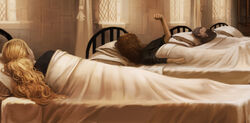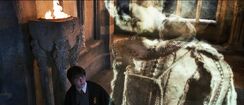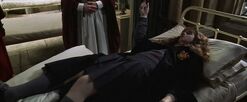Tag: Visual edit |
(Adding categories) |
||
| Line 67: | Line 67: | ||
[[Category:Plot to open the Chamber of Secrets]] |
[[Category:Plot to open the Chamber of Secrets]] |
||
[[Category:Transformations]] |
[[Category:Transformations]] |
||
| + | [[Category:Magical powers]] |
||
Revision as of 01:25, 3 March 2019

Victims of Petrification turned to stone
- "Dark Magic of the most advanced kind."
- — Albus Dumbledore regarding petrification[src]
Petrification is the process of being turned to stone. The only proven causes of petrification are the gaze of the Gorgon and the Basilisk, the latter only when reflected in or seen through another object. However, there may be a Dark spell that does the same. It is considered to be dark magic of the most advanced kind, of which no normal second year student could accomplish. It should not be confused with the Full Body-Bind Curse or the Hardening Charm.
Effects
Victims of petrification are paralysed and unmovable, and seem to be unconscious; it takes careful examination to discern whether a victim is petrified or dead. The difference between petrification and death is that the petrified victim appears to enter rigour mortis instantaneously and remains that way, while a dead person enters, and leaves it, within a normal time frame. A petrified ghost will turn a dark smoky grey and can only be moved using a fan. The only effective remedy for petrification is a draught made of Mandrake roots.
The Full Body-Bind Curse is similar to petrification, but it is temporary and easily lifted. The victim is fully conscious when cursed, so it is not nearly as dangerous. Transmogrifian Torture has been said by Gilderoy Lockhart to cause death and petrification; however, the truth of his claims are dubious.
The Chamber of Secrets was opened twice, which released Salazar Slytherin's Basilisk into Hogwarts. The first opening in 1943 resulted in the death of a student, Myrtle Warren[1]. Three other students were petrified that year. The second opening in 1992 petrified several muggle-born students whom the basilisk had intended to kill, but had failed.
Known victims
- "The basilisk kills people by looking at them. But no one’s died — because no one looked it straight in the eye. Colin saw it through his camera. The basilisk burned up all the film inside it, but Colin just got Petrified. Justin... Justin must’ve seen the basilisk through Nearly Headless Nick! Nick got the full blast of it, but he couldn’t die again... and Hermione and that Ravenclaw prefect were found with a mirror next to them. Hermione had just realised the monster was a basilisk."
- — The known victims of petrification[src]
| Victim | Circumstances |
|---|---|
| Mrs Norris | Saw the basilisk's reflection in the water on the floor. |
| Colin Creevey | Saw the basilisk through his camera; the basilisk's gaze also burned his camera's film to a crisp. |
| icholas de Mimsy-Porpington | Saw the basilisk directly, but as a ghost he could not die again. |
| Justin Finch-Fletchley | Saw the basilisk through Nick, who was transparent, did not see the basilisk directly. |
| Hermione Granger | Saw the basilisk in Penelope's mirror, while near the Hogwarts library. |
| Penelope Clearwater | Saw the basilisk in her mirror; it is possible that Penelope is a half-blood, and was only subject to an attack because she was there when the basilisk petrified Hermione, a Muggle-born, but it is unknown. |
| Students of Hogwarts (1943) | During the incident of the first unleashing of the beast in 1943, several unamed Hogwarts students were petrified. |
Etymology
The Latin verb petrificare means "to make into stone", from the Latin word for "rock", petra.
Behind the scenes
- It is unknown how Nearly Headless Nick was revived from being petrified, because, as a ghost, he presumably would not have been able to consume the antidote. (However, as petrified humans cannot consume potions either, being unconscious, perhaps the antidote is administered in a way that could also revive ghosts.)
- In mythology, petrification is associated with Medusa the Gorgon and the cockatrice as well as the basilisk. In Cornish folklore, petrification legends explain the origin of prehistoric megalithic monuments, such as the Merry Maidens stone circle.[2]
- In the film adaptation of Harry Potter and the Philosopher's Stone, Quirinus Quirrell appeared to be turned to stone when touched by Harry, due to the latter's counter-charm reacting to Voldemort (to whom Quirrell was biologically linked), and eventually crumbled apart. This form of petrification was not seen in anywhere else in the series.
Appearances
- Harry Potter and the Chamber of Secrets (First appearance)
- Harry Potter and the Chamber of Secrets (film)
- Harry Potter and the Chamber of Secrets (video game)
- Harry Potter: A Pop-Up Book (Mentioned only)
- Harry Potter Trading Card Game
- Pottermore
- Wonderbook: Book of Spells
- Harry Potter: The Creature Vault (mentioned only)
